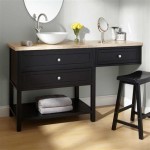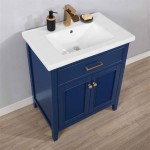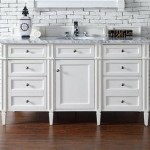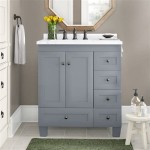```html
Can You Paint Bathroom Furniture? A Comprehensive Guide
Painting bathroom furniture is a viable and cost-effective method to refresh the look of a bathroom without undertaking a complete renovation. However, the success of such a project hinges on meticulous preparation, appropriate material selection, and careful application. The humid environment of a bathroom presents unique challenges that differentiate painting bathroom furniture from, for instance, painting furniture in a living room. This article will delve into the process of painting bathroom furniture, covering the essential steps and considerations for achieving professional-looking and durable results.
Assessing the Existing Furniture and Environment
Before commencing any painting project, it is crucial to evaluate the existing furniture thoroughly. The material of the furniture – whether wood, laminate, or metal – will dictate the appropriate primer and paint to use. Solid wood furniture offers the most straightforward painting experience, while laminate and metal require specialized primers to ensure proper adhesion. Existing damage, such as scratches, dents, or water damage, must be addressed before painting to prevent these imperfections from being amplified by the new paint layer. Furthermore, assess the ventilation in the bathroom. Adequate ventilation is paramount, not only for the proper drying and curing of the paint but also for mitigating the health risks associated with paint fumes. If the bathroom lacks suitable ventilation, consider using low-VOC (volatile organic compounds) paints and ensuring ample airflow from adjacent rooms.
The choice of paint color is also an important consideration. Lighter colors can brighten a small bathroom and make it appear more spacious, while darker colors can add a touch of sophistication and drama to larger bathrooms. Consider the existing color scheme of the bathroom – the tiles, walls, and accessories – to ensure that the painted furniture complements the overall aesthetic. It's highly recommended to test paint samples on an inconspicuous area of the furniture to assess the color and finish under the bathroom's lighting conditions.
The style of the furniture should also influence the paint selection and application technique. For instance, ornate furniture with intricate details might benefit from techniques like dry brushing or antiquing to highlight its features, while modern, minimalist furniture may be best suited to a smooth, uniform finish.
Essential Preparation Steps Before Painting
Proper preparation is arguably the most critical stage in painting bathroom furniture. It significantly impacts the paint's adhesion, finish, and longevity. The first step is to remove the furniture from the bathroom, if possible, or create ample workspace by covering surrounding surfaces with drop cloths or plastic sheeting. If the furniture is fixed in place, ensure maximum ventilation by opening windows and using exhaust fans.
Next, thoroughly clean the furniture using a degreaser or a solution of mild soap and water. This removes dirt, grime, grease, and any existing residues that could interfere with the paint's adhesion. For stubborn stains, such as mildew or mold, use a specialized cleaner formulated for bathroom environments. Rinse the furniture thoroughly with clean water and allow it to dry completely before proceeding.
Once the furniture is clean and dry, sanding is the next crucial step. Sanding roughens the surface, creating a better grip for the primer and paint. Use medium-grit sandpaper (around 120-180 grit) for the initial sanding, followed by fine-grit sandpaper (around 220 grit) for smoothing the surface. Focus on areas with existing paint, varnish, or imperfections. For laminate furniture, sanding is particularly important to remove the glossy surface and expose the underlying material. After sanding, wipe down the furniture with a tack cloth to remove any sanding dust. Dust can compromise the paint finish, creating a rough or uneven surface.
After sanding and cleaning, remove any hardware, such as knobs, handles, and hinges. This ensures a clean, professional paint job and prevents paint from getting onto the hardware. If the hardware is old or tarnished, consider replacing it with new hardware to further enhance the updated look of the furniture. If you intend to reuse the existing hardware, clean it thoroughly and store it in a safe place to prevent loss or damage.
Finally, apply painter's tape to any areas that you do not want to paint, such as the edges of mirrors or countertops. Ensure that the tape is applied firmly and smoothly to prevent paint from bleeding underneath.
Selecting the Right Paint and Application Techniques
Choosing suitable paint and primer is paramount when painting bathroom furniture. The high humidity and potential for water exposure necessitate using products specifically designed for bathroom environments. Primers create a barrier between the furniture surface and the paint, promoting adhesion and preventing tannins from bleeding through from wood. Oil-based primers are exceptionally durable and provide excellent adhesion, but they require mineral spirits for cleanup and emit strong odors. Water-based primers are low-VOC and easy to clean up, but they may not be as effective on oily or glossy surfaces. For laminate furniture, use an adhesion primer specifically formulated for non-porous surfaces.
For the paint itself, select a moisture-resistant paint with a mildew-resistant formula. Semi-gloss or gloss finishes are typically recommended for bathroom furniture because they are more durable and easier to clean than matte finishes. However, gloss finishes also accentuate imperfections, so thorough surface preparation is crucial. Latex-based paints are generally preferable for bathroom furniture due to their flexibility and resistance to cracking and peeling. Oil-based paints offer superior durability but are more prone to yellowing over time and require more effort for cleanup.
The application technique can significantly impact the final result. A high-quality brush or roller is essential for achieving a smooth, even finish. For smaller, intricate details, use a small brush with soft bristles. For larger, flat surfaces, use a foam roller or a high-density foam brush. Apply thin, even coats of paint, allowing each coat to dry completely before applying the next. Avoid applying thick coats of paint, as this can lead to drips, runs, and uneven drying. Lightly sand between coats with fine-grit sandpaper to remove any imperfections and create a smoother surface for the next coat.
Consider using a paint sprayer for a professional, flawless finish. Paint sprayers offer excellent coverage and can be particularly useful for painting furniture with intricate details or hard-to-reach areas. However, paint sprayers require practice and careful setup to avoid overspray and uneven application. Always follow the manufacturer's instructions for the paint sprayer and ensure proper ventilation when using this method.
After applying the final coat of paint, allow the furniture to dry and cure completely before reassembling it and placing it back in the bathroom. Curing can take several days or even weeks, depending on the type of paint used. During the curing process, avoid exposing the furniture to excessive moisture or humidity.
Once the paint is fully cured, reattach the hardware and carefully inspect the furniture for any imperfections. Touch up any areas as needed. Finally, clean the furniture with a soft cloth and a mild cleaner.
By following these steps, one can successfully paint bathroom furniture and achieve a durable, professional-looking finish that enhances the aesthetics of the bathroom.
```
How To Paint Bathroom Cabinets Without Sanding 8 Vital Steps Grace In My Space

How To Completely Change Bathroom Cabinets With Paint Roots Wings Furniture Llc

How To Quickly Paint A Bathroom Vanity Cabinet Entri Ways

How To Paint Bathroom Vanity Cabinets Tutorial Benjamin Moore
.jpg?strip=all)
Painting A Bathroom Vanity Again Dream Green Diy

Painting Bathroom Cabinets Nq Property Care

Bathroom Refresh Update With Paint Deeply Southern Home

21 Beautiful Painted Bathroom Cabinet Ideas

How To Paint Cabinets Last Painting A Bathroom Vanity Maison De Pax

Tips To Painting Bathroom Cabinets Rock Solid Rustic
Related Posts







